As an Amazon Associate I earn from qualifying purchases.
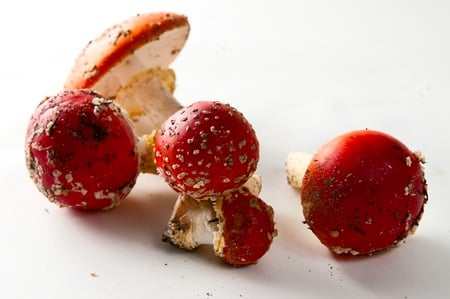
Editor’s Note: I have said this a lot in the comments before, in person and in the body of this post. Let me say it one more time, right up here in the beginning: Unless you are an expert mushroom hunter and you can 100 percent identify this mushroom, DON’T EAT IT. I wrote this post for other experts, not for just anyone to think they’ve found A. muscaria. This is serious stuff, folks. Mistake this mushroom for another amanita and you can die. Seriously. ~Hank
No mushroom presents more of an enigma than the fly agaric, Amanita muscaria. It is the most recognizable mushroom on the planet, and is widely known as the hallucinatory ‘shroom responsible for Alice’s trip into Wonderland and quite possibly our beloved images of a red-suited Santa Claus and his flying reindeer.
I am not into hallucinations. Or stomach cramping, for that matter. So for years I let this beautiful mushroom pass on my mushroom hunts. Until last weekend. We were ostensibly hunting for porcini, Boletus edulis, but as any king bolete hunter knows, the fly agaric is literally a red flag indicating that a porcino might be nestled nearby: They flush around the same time, in around the same place. And where we were on California’s Central Coast there were thousands of muscaria, a red tide in the woods.

As we walked, picking porcini and other wonderful boletes, I began having a nagging conversation with myself: You know you can eat those amanitas, right? Yes, but don’t they need all sorts of crazy processing first? Probably. But you will never get a better chance to experiment than with this flush right here, right now. OK, OK. I grabbed a separate bag and began picking.
I filled a grocery bag in no time. In fact, I could have filled the back of my pickup with muscaria. But I also had a huge haul of porcini, the prize of the day. So I dealt with them first. My dehydrator ran morning and night for days. I made porcini powder, dried quarts of porcini, made porcini risotto, and even gave some fresh ones as Christmas presents. All the while my sack of amanitas lay neglected in the garage.
I came up for air a few days ago and decided to do some research. I have a lot of mushroom books. Most say that Amanita muscaria is toxic and hallucinatory. A few call it deadly poisonous, which seems to be a stretch considering there are fewer than a handful of confirmed deaths by this mushroom and all have extenuating circumstances. (A side note: fly agaric appears to be attractive to dogs and cats and can kill them if they eat it, so keep it away from your pets!)
There is also, apparently, an entire modern subculture dedicated to tripping on this mushroom, and its use in visions dates back thousands of years — especially among those who live in the boreal forests of the north.
This is where Santa comes in. My colleague Greg Marley, whose excellent book Chanterelle Dreams, Amanita Nightmares: The Love, Lore, and Mystique of Mushrooms goes into this at length, says that fly agaric has been a symbol of yuletide happiness in Central Europe, Russia and Scandinavia for centuries, calling it “a red light shining bright in the winter darkness.” And the people of the North, as any mushroom hunter knows, are mad about mushrooms.
There is a common exchange between us Anglo ‘shroomers when we see various, “lesser” species of ‘shroom: Is it edible? Well, the Russians eat it… Amanita muscaria falls into this category.
Historically, the Siberians boiled fly agaric and then drank the pot liquor to get roaring drunk. They then preserved the mushrooms for eating later. As it happens, the Siberians’ livestock also loves this ‘shroom. And I’m not talking about cattle, I’m talking about reindeer.
Yep. Caribou will seek out Amanita muscaria just for the high — or at least it looks that way to us humans. So it’s not too far a stretch to conjure up an image of a jolly, roaringly drunk, fat, bearded dude all dressed up for the North Pole — in a red suit with white trim — chillin’ with flying reindeer.
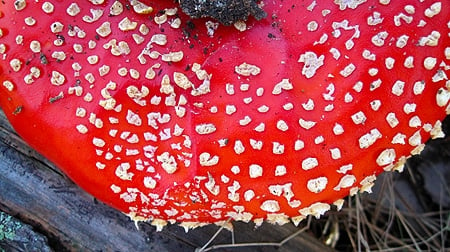
But like I said, I am not into that sort of thing. So I looked deeper. It seems that the primary toxins, er, “active ingredients,” in Amanita muscaria are ibotenic acid and muscimol. Unlike the amatoxins in the deadly amanitas — the death cap and the destroying angel — ibotenic acid and muscimol are water soluble.
More research turned up William Rubel, who knows his stuff when it comes to mushrooms. Rubel wrote an article about how to detoxify fly agaric that proved enlightening.
What’s more, he and David Arora, who is even more reknowned in the mycological world, teamed up on a longer piece (which is linked to at the bottom of Rubel’s article) about cultural attitudes toward Amanita muscaria that provides all the detail you could need on why this mushroom has such a varied place in our minds: Food. Poison. Hallucinogen.
As food, fly agaric does need special handling. Apparently most people eat only the caps or the very young buttons. They must be boiled in a large volume of water for a period of time, and then you need to toss out that water. After that, most cultures will either fry them like normal mushrooms, or pickle them, or preserve them in oil; I happen to know that a certain set of Italians do this. The Japanese around Nagano eat Amanita muscaria as pickles, as do the Lithuanians, Finns and Russians.
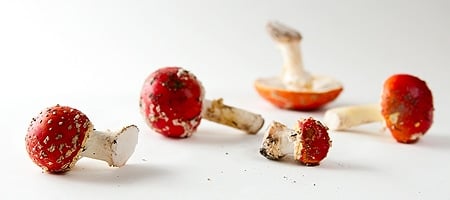
My friend Langdon Cook wrote about eating fly agaric with none other than David Arora, and he pronounced them delicious. Lang also pointed me to a cautionary article written by two mycologists who, apparently, failed to detoxify their muscaria enough. The moral of that article is to use lots of water and boil the hell out of the shrooms.
Back to my grocery bag. By the time I’d screwed up enough courage to mess around with these things, about half had gone by. Bummer. But I still had about 10 good caps to experiment with. What follows is what I did to detoxify the mushrooms. If you choose to play around with Amanita muscaria, do so at your own risk.
- I first removed all the caps and cleaned them with a brush and the side of a knife. Then I cut the caps into 1/4 inch slices.
- I filled my 12-quart stockpot up to the top, leaving about 3 inches of room to spare. I added enough salt to make the water taste salty and 1 cup of cider vinegar. Several sources say that adding salt and vinegar helps extract the toxins.
- I brought this to a boil and added the mushroom caps, then let it roll for 15 minutes.
- I then drained the mushrooms and filled the stockpot half full with fresh water and brought that to a boil. In went the mushrooms for another 5 minutes. Why? If they had gotten too vinegary or salty, this would help. Also, better safe than sorry.
The key to boiling seems to be time and water volume. You need enough water to leach out all the toxins of the mushroom, so it follows that the more muscaria you boil, the more water you’ll need. As for time, it seems 15 minutes is a pretty good interval, according to my sources.
When the slices were done with this treatment, almost all the color was gone from the previously pretty red caps. Oh well. They were still a vague ivory-yellow, but the mushrooms themselves were pale and slippery. Not appetizing. Lang and Arora ate them fried in butter, so I did the same.
I experimented with about 1 cap’s worth of slices. It is always wise to start small with any new mushroom, and especially one that has potentially toxic effects. I put the slices into a non-stick pan and let them dry saute for a few minutes. They did not exude too much water, oddly, so I added some butter and a little salt. I was happy to see the slices fry up crispy. Now we’re talking!
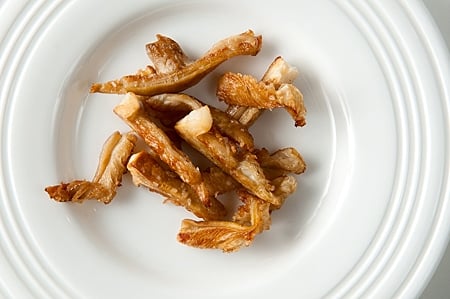
I put them on a little plate, and tentatively took a bite. I’d be lying if I told you I was not at least a little nervous. I tasted butter and salt at first, always nice, but then I got a little crisp, then the squinchy crunchiness of the mushroom, then that nutty flavor everyone who’s eaten muscaria talks about. Reflexively, I reached for another slice, then another and another.
I had to force myself to stop at 1 cap’s worth. They were that good. Now it was time to wait.
The mycologists who’d boiled their muscaria in too little water for too short a time started tripping at 20 minutes. So I sat down to watch Boise State beat the crap out of Arizona State and waited. I was wondering if Boise’s crazy blue uniforms would spark some weird hallucination. But no. I looked at my watch: 45 minutes and nothing. The game got boring. Holly and I then watched a show about a bunch of Vikings getting beheaded in England 1000 years ago, which, in retrospect, was probably not ideal if I were about to go on a mushroom trip. But no. I looked at my watch again: Two hours had passed and nothing.
If a trip were coming, it would have hit by then. What’s more, I had neither stomach cramps nor any other ill effects whatsoever. Success!
Now you may be asking yourself why I would bother messing around with Amanita muscaria when I had just hauled in pounds of boletes? First off, fly agaric is one of the easiest mushrooms in the world to identify. Even though it has some color variation, like the yellow-orange one below, if you stick to the red and orange color phases Amanita muscaria is unmistakable.
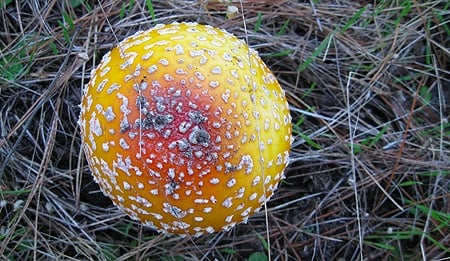
Now white and light-yellow phase muscaria do exist, but I do not recommend messing with those. White amanitas are almost always deadly — the destroying angel chief among them — and mistaking a destroying angel for a white muscaria will be the last mistake you ever make.
And with the yellow ones, you can mistake muscaria for the more-toxic Panther Amanita, Amanita pantherina, which does not have a history of culinary use.
A second reason to consider eating fly agaric is because it is a large mushroom that, as I saw on the Central Coast, can flush in huge numbers. I could easily have collected four grocery bags of them on my last trip, which would have made for lots of good eating down the line.
And good eating is the real reason I will choose to eat Amanita muscaria once or twice a season. It was a delicious mushroom fried in butter, and I suspect it will make an even better preserved mushroom, if the Italians or Russians’ experience is any indication. At the very least, it will be a conversation starter, eh?





As to truly edible, non-toxic amanitas … there are close to seventy named species of amanitas that are eaten as edibles and even sold in markets all around the world. Muscaria is NOT one of them!
Hank has emphasized in both his post here and in the trailing comments, amanitas are NOT a group to mess with if you are a beginner. Deadly amanitas occur all over the world, and cause deaths on a regular basis. The more wild mushrooms are eaten in a society, the greater the number of deaths. Don’t become a statistic!
As to the European Caesars: it is indeed a highly valued edible in Amanita section Caesarea, but I would say that every country has its favorite edible amanita. Saying that caesarea is “the best amanita” is merely a Eurocentric perspective!
I recently tried the SW caesar, provisional name Amanita “cochiseana,” picked outside of Flagstaff this past August, and it was absolutely delicious: MUCH better than either of our two western caesars, the fall coccora (A. calyptroderma) and the spring coccora (A. vernicoccora). It even resembles the European caesar in its orange coloration.
I share Hank’s affection for Amanita velosa, my hands down favorite edible in CA, but it is not a caesar’s mushrooms. In fact, it is one of the colorful grisettes.
Velosas are not just delicious, but potentially deadly. It would be easy for a beginner to mistake a velosa for both a tan capped Amanita phalloides (death cap) or an ocreata (destroying angel); mushrooms come in many different forms and colors, even within species. Velosas frequently show a pure white form, and can literally grow right next to the deadly ocreata under oak trees in the spring. I have also seen almost identical phalloides and velosa growing nearby each other in the Sierra foothills.
It scared me and it should scare you.
Amanitas are very popular edible species around the world (not muscaria though; the incidence of its accepted edibility was way over-stated in the Rubel/Arora paper), but in places outside of the US, amanitas are often purchased in markets, and not directly foraged by random consumers.
Best to admire those beautiful amanitas from afar … afar from your mouth, at any rate, at least for the first several years of mushroom foraging.
Yours in amanita education,
Debbie Viess aka Amanitarita
http://www.bayareamushrooms.org
I am pretty concerned about some of the comments here. It seems like there are quite a few amateur mushroom hunters, who could end up very ill, or worse. I have been picking mushrooms for more than 35 years, and I would probably not pick Amanita Muscaria. In fact the most prized mushroom on earth is from the Amanita family, called Caesar’s Mushroom [Amanita Caesarea], but please be very, very, very careful when picking Amanitas.
Charles: But of course. And I too have been picking for decades, thus my cautions and procedures for de-toxing this mushroom, which can be super abundant in my area. My favorite amanita is A. velosa, which is a little like the Caesar’s mushroom.
Just got back from Salmon fishing up on the Kola Peninsula and found a bunch of these, all of which I hauled home with me. Really looking forward to trying them. Thanks again, as always, for maintaining this wonderful site!
The best way, is too get about half a cup of fresh Amanita Muscaria fresh and coming out of the ground, place the half cup in large 1 or 2 quart thermos, with 1 fresh squeezed orange, 2 black tea bags and 2 teaspoons of honey, now let the concoction brew for two hours, than pour out the fluid and strain the mushroom parts from the fluid. Now in a safe setting slowly drink the warm delicious tea one cup at a time and wait one hour, keep at it until the quart is done or you feel so heavenly you cannot take anymore. To waste these
wonderful mushrooms by boiling off the ‘essential ingredients’ simply to eat them, a criminal waste of resources. No experience in your life will be better if you have fresh potent Amanita Muscaria (after an August Rain), I know recently had some from Frank Church Wilderness of no Return Idaho.
Brian: Like I said. I am not into that sort of thing.
Forgot to add I am in the boreal forests of Central Canada about 50 deegrees north in Ontario.
I’ve recently found an orange cap fly agaric along with the usual boletes I eat regularly. I found false moral earlier this year, and have parboiled it previously. I’ve been foraging for about 10 years now. I am wondering if alchohol such as rum can be substituted for the vinegar, as all I have is ukrainian ginvodka and mexican rum no vinegar. I am very curious about this. I’ve eaten tons of mushrooms so far chantrelle have been the tastiest, but I am very curious on this. Will research more. I have been trying to dry it out on a Mayan style mushroom head sitting monkey sandstone or limestone idol I got around Catamaco Veracruz Tabasco Mexico. I usually dry out my mushrooms by placing them in the round holes of the arms. It works, not sure if that is its traditional use as a mushroom drying altar. Will report back later this week on how things went. Its been cloudy with sparse rain so drying is being delayed a litte.
William: Honestly, I am not sure.
if you dont want to die stick to red caps and white spots (this can be washed away by rain tho), no yellow, no orange or yellow to red fade.
I live in Ontario and these little buggers are everywhere, btw you can eat a proper Amanita muscaria on its own, minor stomach cramps, (nothing compared to Peyote) and a sky high trip more powerful than mexican blue caps. not a food mushroom hunter here 🙂 just a boy scout that learned how to get f****d up for free
Would the spore prints of deadly amanitas differ from the ones you can boil? I know the spore prints are white, but would anything clearly set them apart doing a print?
I found this blog and I don’t know how. I like it!
I could not contain myself when I read the gentlemans post above. The one in all caps. I appreciate his insight and experience. I do not take eating mushrooms lightly and heed the repeated warnings given by all.
But that all caps post had me roaring! I just saw someone all tripping out saying it’s not so bad, really it isn’t!
I once got mushrooms called Mexican red caps. I ate them and rather enjoyed my trip with no ill effects. Some months later I googled the name and came to learn what they are. I’m certainly interested in finding my own in the future. The trip felt rather more intense than that of the other psycho active mushrooms I have eaten. I only ate a few small caps and stems but I enjoyed myself.
Cool cool read Hank. I have primarily (and sadly) spent most my time on the venison, waterfowl, and pheasant pages on here, and stumbled on to this by accident.
I absolutely love wild mushrooms. And although I have been picking and eating morels for over 10 years now, I am probably still a beginner when it comes to identifying mushrooms. I have had a copy of Arora’s Mushrooms Demystified, and didn’t start using it seriously at all until just this last year.
Well here in Northern Utah we had an unusually rainy august and September which led to an absolutely incredible late summer/early fall push of mushrooms – which, being mostly a morel hunter, was completely new to me. It was a great opportunity to learn to use MD, but it was almost overwhelming the amount of species that were out and abundant.
So we made a pretty good haul of kings and a few other boletes – but sadly missed the best of it. We sauted up a bunch, and dried quite a few more. They have been great in your recipes calling for dried shrooms BTW. But on our last foray, we struggled to find many kings that were in good shape, but the agarics were straight GOING OFF. Kinda like the flush you describe here, although they were the more yellow variety – no red to speak of, and it would be tough to say they had any orange. Man they were beautiful specimens though. I spent a lot of time admiring them wishing they were edible.
It’s winter here right now, so while you have been cleaning up, I have been licking my chops for spring! Sure hope the rain comes again in Aug and Sept tho. I want a do-over!!
They can be found in Kentucky, as well. I used to live in northern California in the Sierra Nevada Mountains around 3,000′ elevation. When these mushrooms were in their full “flush” random people would show up wearing knee pads and crawl around the forest floor to LICK the red caps. Do you know anything about this or what this might taste like? Only a few would actually pick them (with my approval and warning, of course).
These can be found as far south as middle Georgia – any further south and I can’t tell you but definitely mid GA. They grow all around my lake property (on Lake Jackson; there are allot of pine trees around), but I am not one to chance trying them.
I live in Miami Florida , and as yet I haven’t seen any in the Everglades. I’m willing to follow the recipe to the letter. Do they grow this far south, or am I wasting my time?
Reynald: I think you are wasting you time. Pretty sure they don’t exist that far south.
Hi Hank,
This is certainly a storied mushroom, fun to see, fun to talk about, fun to speculate upon, but sometimes not so fun when eaten. As you know, I wrote a well-researched rebuttal to the Rubel/Arora paper, published last December in “Mushroom, the Journal of Wild Mushrooming.” During my several years of research into this topic, I discovered a number of modern deaths attributed to eating muscaria. People who were not quite cautious enough and ate too much as a drug, not for food, fell into a coma, and died from aspirating vomitus or freezing to death. There have also been more visits to the ER by folks who over-indulged in muscaria, and some of them are citing the Arora paper as the reason that they did.
I also discovered several documented recent deaths in Tanzania, where locals ate muscaria as food, after mistaking them for commonly eaten reddish amanitas in the caesarea group. Muscaria was introduced into Tanzania on the roots of pine trees, in an area where they didn’t grow before.
This is far from a “harmless” mushroom. It IS the toxic lookalike. Yes, with careful and special preparation, you can boil away most of the toxins (don’t forget to throw out that toxic water, too!), but then you have also boiled away the flavor. Carmelizing those soggy bits is what adds it back. But why in heaven’s name would you start with a toxic mushroom, anyway?
But don’t take my word for it. Read the entire paper here:
https://mushroomthejournal.com/bestof/muscaria_revisited.pdf
Enjoy the rains and the many beautiful and sometimes even truly edible mushrooms that they are creating. I know that I am!
Debbie Viess
Bay Area Mycological Society
http://www.bayareamushrooms.org
Thank you for this recept ,I will try it.
There are lost of Amanita Muscaria at the moment here.
Perry,
The Netherlands.
I can report from the Netherlands, that Dutch A. muscaria is extremely tasty. I followed Hank Shaw’s instructions except that I cooked the stalks along with the caps. I stuck to the 15 minutes with a lot of water, with quite a bit of salt and a little vinegar, plus an extra 5 minutes in fresh water. It is being an exceptionally good year for wild mushrooms.
Yes, I ate a quart pot full of them on a back pack trip to Bighorn Crags Idaho Frank Church Wilderness in the Salmon National Forest, I misidentified them, they were just coming through the forest floor of pine duff. Not soon after I went for a little walk as nature was calling, and barely made it back to my camp, I got in the tent and was ‘knocked out’ for 12 hours, during the night I was convulsive and had severe muscle spasms, all I remember was dreaming, at dawn Salmon Search and Rescue arrived on foot and horseback to extract me, summoned by my cell phone by my 10 year old son, the horses however could not get to our camp so 2 hours later I was extracted by Black Hawk Helicopter via 101st Airbourne Division to Steele Memorial Hospital Salmon where I spent 2 days, I hallucinated for 2 days, and was severely high and euphoric for four days, it took nine days for the high to go away. We went back a year later and identified the Mushrooms, they were yellowish brown, but definitely a species of Amanita, it had rained for 10 days strait before we arrived and there was lots and lots of these mushrooms as well as others. Two days after I was air lifted from our remote camp close friend of 33 years went in to get what was left of my camp and had a heart attack and died. A case of truth being odder than fiction.
A. muscaria has numerous variants across the globe. Evidently, the level of toxicity can vary depending on numerous variables – like region, soil (including root associations) and, perhaps, even seasonal changes. I think too many folks are drawn to experiment with these fungi without really considering the consequences, while others imagine themselves to be far more expert mycophagist’s than the reality.
Stephen: Very true. All I can tell you is this method works great here in the Pacific Northwest. And I agree: A lot of people are a bit too cavalier about this mushroom…